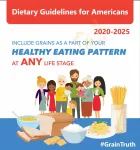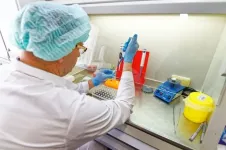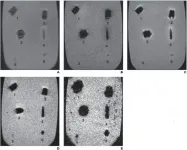UCLA scientists develop high-throughput mitochondria transfer device
Method will help researchers better understand mitochondrial DNA diseases
2021-01-02
(Press-News.org) LOS ANGELES -- Scientists from the UCLA Jonsson Comprehensive Cancer Center have developed a simple, high-throughput method for transferring isolated mitochondria and their associated mitochondrial DNA into mammalian cells. This approach enables researchers to tailor a key genetic component of cells, to study and potentially treat debilitating diseases such as cancer, diabetes and metabolic disorders.
A study, published today in the journal Cell Reports, describes how the new UCLA-developed device, called MitoPunch, transfers mitochondria into 100,000 or more recipient cells simultaneously, which is a significant improvement from existing mitochondrial transfer technologies. The device is part of the continued effort by UCLA scientists to understand mutations in mitochondrial DNA by developing controlled, manipulative approaches that improve the function of human cells or model human mitochondrial diseases better.
"The ability to generate cells with desired mitochondrial DNA sequences is powerful for studying how genomes in the mitochondria and nucleus interact to regulate cell functions, which can be critical for understanding and potentially treating diseases in patients," said Alexander Sercel, a doctoral candidate at the David Geffen School of Medicine at UCLA and co-first author of the study.
Mitochondria, often known as the 'powerplant' of a cell, are inherited from a person's mother. They rely on the integrity of the mitochondrial DNA to perform their essential functions. Inherited or acquired mutations of the mitochondrial DNA can significantly impair energy production and may result in debilitating diseases.
Technologies for manipulating mitochondrial DNA lag behind advances for manipulating DNA in the nucleus of a cell and could potentially help scientists develop disease models and regenerative therapies for disorders caused by these mutations. Current approaches, however, are limited and complex, and for the most part can only deliver mitochondria with desired mitochondrial DNA sequences into a limited number and variety of cells.
The MitoPunch device is simple to operate and allows for consistent mitochondrial transfers from a wide range of mitochondria isolated from different donor cell types into a multitude of recipient cell types, even for non-human species, including for cells isolated from mice.
"What sets MitoPunch apart from other technologies is an ability to engineer non-immortal, non-malignant cells, such as human skin cells, to generate unique mitochondrial DNA-nuclear genome combinations," said co-first author Alexander Patananan, a UCLA postdoctoral scholar, who now works at Amgen. "This advance allowed us to study the impact of specific mitochondrial DNA sequences on cell functions by also enabling the reprogramming of these cells into induced pluripotent stem cells that were then differentiated into functioning fat, cartilage, and bone cells."
MitoPunch was created in the labs of Dr. Michael Teitell, director of the Jonsson Cancer Center and professor of pathology and laboratory medicine, Pei-Yu (Eric) Chiou, professor of mechanical and aerospace engineering at the UCLA Henry Samueli School of Engineering and Applied Science, and Ting-Hsiang Wu, from ImmunityBio, Inc., Culver City, CA.
MitoPunch builds upon prior technology and a device called a photothermal nanoblade, which the team developed in 2016. But unlike the photothermal nanoblade, which requires sophisticated lasers and optical systems to operate, MitoPunch works by using pressure to propel an isolated mitochondrial suspension through a porous membrane coated with cells. The researchers propose that this applied pressure gradient creates the ability to puncture cell membranes at discrete locations, allowing the mitochondria direct entry into recipient cells, followed by cell membrane repair.
"We knew when we first created the photothermal nanoblade that we would need a higher-throughput, simpler to use system that is more accessible for other laboratories to assemble and operate," said Teitell, who is also the chief of the division of pediatric and developmental pathology and a member of the UCLA Broad Stem Cell Research Center. "This new device is very efficient and allows researchers to study the mitochondrial genome in a simple way -- swapping it from one cell into another -- which can be used to uncover the basic biology that governs a broad range of cell functions and could, one day, offer hope for treating mitochondrial DNA diseases."
INFORMATION:
The research was supported by the National Institutes of Health, by the American Heart Association and by the Human Performance and Biosystems division of the US Air Force Office of Scientific Research.
ELSE PRESS RELEASES FROM THIS DATE:
2021-01-02
AURORA, Colo. (Dec. 29, 2020) - College football players may underestimate their risk of injury and concussion, according to a new study published today in JAMA Network Open.
Christine Baugh, PhD, MPH, assistant professor of medicine at the University of Colorado School of Medicine and member of the CU Center for Bioethics and Humanities, is the corresponding author of the article, "Accuracy of US College Football Players' Estimates of Their Risk of Concussion or Injury."
Baugh and co-authors report on survey results of 296 college football players from four teams in the Power 5 Conferences of ...
2021-01-02
People have puzzled for years why pathogen Phytophthora infestens causes the devastating late blight disease, source of the Irish Potato famine, on potatoes, but has no effect at all on plants like apple or cucumber. How are apple trees and cucumber plants able to completely shake off this devastating pathogen? Agricultural scientists have wondered for years: if this resistance is so complete and persists over so many generations, is there some way we could transfer it to susceptible plants like wheat and thereby stop disease?
Why is it so important to determine the molecular basis of nonhost resistance? ...
2021-01-02
Toronto - With the arrival of effective vaccines for the COVID-19 virus, the end of the pandemic is on the horizon but in the short term the virus continues to spread.
A timely new study published today by PLOS ONE examines the effectiveness of COVID-19 control policies in 40 jurisdictions including countries and U.S. states.
Among the conclusions is that significant social costs must be incurred to reduce the growth of the virus below zero. In most jurisdictions examined, policies with a lesser social impact including cancellation of public events, restrictions of gatherings ...
2021-01-02
The Grain Chain, a farm to fork coalition of stakeholders in the grain industry sector and chaired by the American Bakers Association (ABA), celebrates the recommendation published today in the 2020-2025 Dietary Guidelines for Americans (DGAs) to "consume half of your grains from whole grain sources" and the remainder from enriched grains. A foundational piece of the DGAs, the guidelines recognize whole grains are "one of the three food groups that are fundamental constituents of a healthy dietary pattern."
The United States Department of Agriculture (USDA) and Health and Human Services (HHS) oversee and publish the Dietary Guidelines, ...
2021-01-02
BIRMINGHAM, Ala. - COVID-19, which has killed 1.7 million people worldwide, does not follow a uniform path.
Many infected patients remain asymptomatic or have mild symptoms. Others, especially those with comorbidities, can develop severe clinical disease with atypical pneumonia and multiple system organ failure.
Since the first cases were reported in December 2019, the SARS-CoV-2 virus that causes COVID-19 has surged into a pandemic, with cases and deaths still mounting. Ongoing observational clinical research has become a priority to better understand how this previously unknown virus acts, and findings from this research can better inform treatment and vaccine design.
University ...
2021-01-02
Carrageenans, biologically active polysaccharides isolated from red algae and widely used in the food industry as stabilizers, thickeners, or jelly agents have an express effect on the immune systems of mice, a study reports. The research was carried out by scientists from the School of Biomedicine of Far Eastern Federal University (FEFU), Far Eastern Branch of the Russian Academy of Sciences, and Vilnius University. A related article appears in the Journal of Biomedical Materials Research.
"The fact that carrageenan demonstrates immunosuppressive properties in a particular case does not make it generally dangerous or toxic though", says Aleksandra ...
2021-01-02
Leesburg, VA, December 29, 2020--According to an article in ARRS' American Journal of Roentgenology (AJR), because patients with ballistic embedded fragments are frequently denied MRI (due to indeterminate bullet composition sans shell casings), radiography and CT can be used to identify nonferromagnetic projectiles that are safe for MRI.
"Commercially available handgun and shotgun ammunition representing projectiles commonly encountered in a clinical setting was fired into ballistic gelatin as a surrogate for human tissue," explained first author Arthur J. Fountain from the department of radiology and imaging sciences at Emory ...
2021-01-02
While the world has its eyes on vaccines to stop the spread of coronavirus, therapeutics are still necessary to treat hospitalized patients. One of these treatments, remdesivir, is the first and only antiviral agent of its kind that the U.S. Food and Drug Administration (FDA) has approved so far for COVID-19.
Research at the University of Cincinnati, however, contends that this antiviral drug is being used too indiscriminately when treating patients hospitalized with the virus. The study is published in the journal Fundamental & Clinical Pharmacology.
The FDA approved remdesivir, marketed as Veklury, for emergency use authorization in May 2020 to treat COVID-19 and granted full approval ...
2021-01-02
Mobile apps have revolutionised the way people meet in Switzerland and elsewhere in recent years. Unlike traditional dating sites, these apps do not feature detailed user profiles but are largely based on rating photos using a swipe review system. As dating apps escalated in popularity, so has criticism about them encouraging casual dating only, threatening the existence of long-term commitment, and possibly damaging the quality of intimacy. There is no scientific evidence, however, to validate these claims. A study by the University of Geneva (UNIGE), Switzerland, provides a wealth of information about couples who met through dating apps, drawing on data from a 2018 Swiss survey. The results, ...
2021-01-02
Very low birthweight infants often need blood transfusions to survive. A National Institutes of Health-funded study suggests that providing a higher threshold of red cells within accepted limits offers no advantage in survival or reduction in neurological impairment over a lower threshold. The research was conducted by Haresh Kirpalani, B.M., of the University of Pennsylvania, Philadelphia, and colleagues and was funded by the NIH's Eunice Kennedy Shriver National Institute of Child Health and Human Development (NICHD), National Heart, Lung, and Blood Institute, and National Center for Advancing Translational Sciences. The study appears in The ...
LAST 30 PRESS RELEASES:
[Press-News.org] UCLA scientists develop high-throughput mitochondria transfer device
Method will help researchers better understand mitochondrial DNA diseases






